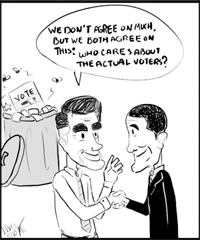In my Sept. 7 editorial “Driving Against Time,” I made the argument that campaigns targeting texting and driving are, even if successful, only half-measures. Even if cell phone use while driving the vehicle miraculously ended, we would still seek outlets to fulfill our urge to be distracted. Adjusting the radio, rubbernecking, talking to passengers and simply daydreaming are acts that have been performed behind the wheel long before the use of cell phones. Until the very nature of driving is overhauled, say, by the advent of the “driverless” car, highway safety will continue to be at the discretion of our ability to stay focused on the task of driving and driving alone.
Nonetheless, texting and driving is a deadly activity, one that was an area of focus in the business section of The New York Times earlier this month. Two articles, both written by Pulitzer Prize-winning author Matt Richtel, explore the efforts being made on the technological and individual level.
The first article, titled “Trying to Hit the Brake on Texting While Driving,” is about Scott Tibbitts, an entrepreneur who has spent five years and $450,000 of his own wealth coming up with a practical technological solution to this reckless habit. Tibbitts’ solution is, in a nutshell, a black box that plugs into the car’s OBD 2 port, a standard feature in cars built after 1996. This “telematics” device blocks cell phones from receiving calls, texts or emails while the car is being driven. Tibbitts has resolved to bring this technology into the consumer market. If he is successful, then the aforementioned miracle of halting cell phone use in the car might be realized. Thus far, Tibbitts has managed to get Sprint on board, at least initially. As of late, the project has been stalled indefinitely due to legal issues and fear of consumer disinterest, both of which threaten Sprint’s “big picture.” Sprint’s Vice President for Business and Product Development Wayne Ward does not want to jeopardize the “brand of a $35 billion company,” as he puts it.
The legal fear, Richtel explains, is that the technology might have a glitch, that a text message might slip through and that the person reading it might get into an accident. “What does that mean for our brand and our business?” says Ward. I do not have an answer to Ward’s question, nor should anybody, for it is pretty clear that this “fear” is yet again nothing but a mere excuse for a corporation to save its bottom line.
As far as consumer disinterest goes, the concern is legitimate. How can society be convinced of the necessity of this telematics device? “It’s like trying to make condoms cool,” Tibbitts said, making an appropriate comparison. Condoms are cool because they allow people to have sex without potential health risks. Tibbitts’ device, if accepted by society, would be seen as cool for a similar reason, that it prevents the risk of getting into an accident while texting and driving.
My previous editorial articulated the issue of human distractibility, but it did not answer the crucial question of why we are so prone to distraction. Richtel’s second article titled “A Texting Driver’s Education” gives us an answer. The article primarily details the trial and redemption of Reggie Shaw, who in 2006 killed two people as a result of texting while driving. As compelling as Shaw’s story is, what struck me most from the article was the “scientific journey” about distracted behavior that the prosecutors brought forth at his trial.
The journey starts with a hypothetical prehistoric man preparing a fire. The task requires great focus and thus relies on the most advanced part of the brain, the prefrontal cortex. Yet other more primitive parts of the brain are ready to alert prehistoric man, say, of an approaching beast of prey, so that he can flee to safety.
The journey fast-forwards to the digital age. Rampant technology use has caused balance between these two brain functions to become “seriously out of whack.” Modern man is driving a car when he receives a text message. It could be the driver’s mom with dire news about his dad’s health, or it could just be the driver’s friend asking, “Chipotle or Moe’s?” According to Richtel, “the fact that the information is of variable value actually increases its magnetism.” The uncertainty creates a lure called “intermittent reinforcement,” so powerful that it overrides the modern person’s essential task of driving.
We humans are imperfect. When it comes to driving, we are not just imperfect, but borderline incapable. As Richtel’s second article indicates, technology has taken a toll on our ability to stay focused while driving. Since technology is what led to the loss of the neurological balance between focus and alarm, technology ought to be used to mitigate the consequences of having lost that balance. Tibbitts found a way to do so, but only in one aspect. Once we fully come to terms with the fact that we are fundamentally imperfect drivers, we will delegate the task to a more perfect driver: the computer. I believe with conviction that this will be the future of transportation. Google has already designed a computer-driven car that contains no steering wheel, brake or gas pedal. In the coming decades, the computer-driven car will have rendered the human driver obsolete. With just the push of a button, we will become passengers in our own cars, free to do whatever we would like. And if the computer errs and causes a horrible car accident, we can blame the computer rather than ourselves.
– By Erik Alexander
Erik Alexander is a College senior majoring in economics.





